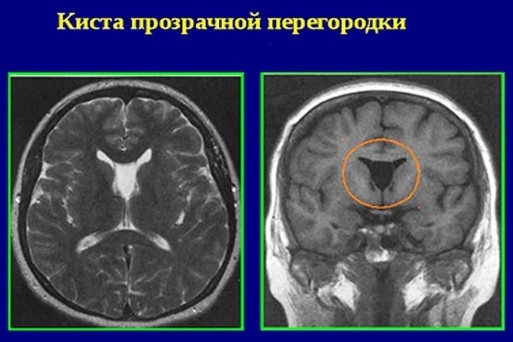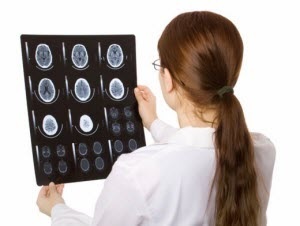Cyst of the brain: definition, species, classification
Contents:
- Causes of development
- Classification of
- Main manifestations of
- Detection of pathology
 Cyst of the brain is similar to a cavity that is filled with liquid( CSF).Despite the fact that education is not a tumor, its large size can pose a threat to the health and life of the patient. Depending on the location of the pathology, these or other brain functions may suffer. Let us consider in more detail what a transparent septum cyst is in the brain, and what kinds of this disease can still be diagnosed.
Cyst of the brain is similar to a cavity that is filled with liquid( CSF).Despite the fact that education is not a tumor, its large size can pose a threat to the health and life of the patient. Depending on the location of the pathology, these or other brain functions may suffer. Let us consider in more detail what a transparent septum cyst is in the brain, and what kinds of this disease can still be diagnosed.
Causes of development of
Most often this disease and its types develop for such reasons:
- Pathology of intrauterine development of the child( congenital defect).
- Head trauma.
- Oncological pathology.
- Postoperative cyst in the brain.
- The presence of pathological inflammatory process.
- Degenerative disorders.
- Intracranial hemorrhage.
- Disturbance of cerebral circulation, which led to necrosis.
Classification
The following are distinguished at the place of education:
- archaoidal formations( located between the shells of the brain and the skull);
- intracerebral formations( located directly in the brain tissues).
Also, in origin, cysts are:
- Congenital( develop with intrauterine air deficiency);
- Acquired( develop after illness, inflammation or severe injury).
Hearing of such a diagnosis, many people are lost, because they do not know what kind of cysts there are. To date, these types of cysts in the brain are distinguished:
- Colloid formation. It is usually congenital and develops when forming the deposits of the central nervous system. As a rule, this disease is almost asymptomatic. It is found at fairly large sizes, when the formation begins to block the flow of fluid through the brain tissue. Her treatment can only be surgical.
- The cyst of the pituitary gland of the brain is a small new growth that is covered with a dense membrane. The pituitary itself is a very important part of the human brain. It contributes to the production of many important hormones that respond to the endocrine system and the overall metabolism.
- Most often this type of disease develops in young people, mostly in women.
- Education in a transparent septum or as it is also called "cyst of the verge of the brain" is a congenital pathology. It develops between the pia mater in the area of the ventricular septum. As a rule, this disease is diagnosed in premature infants.
- Cyst of the cerebellum of the brain is usually accompanied by severe symptoms, so it is diagnosed at an early stage.
- A postischemic cyst in the brain occurs when there is a disturbance of the circulation in the soft tissues and their necrosis. At the same time a person's condition can deteriorate pretty quickly, which will lead to the loss of many important functions of the body.
- Pineal formation is a fairly rare pathology that can be manifested by the pain that occurs when the eyes are raised.
- Education in vascular plexuses can develop in newly-fad children even in the womb. Call this disease can a viral infection called herpes. With timely diagnosed education of this type, the prognosis for the child is favorable, since with proper treatment this formation can resolve without surgery.
- The cyst of the main sinus of the brain can develop due to previously suffered head injuries. It manifests itself as signs of sickness and nausea. With advanced cases, this disease can provoke an increase in pressure.
- The cyst in the ventricles of the brain can develop with prolonged inflammatory process. With timely diagnosis and treatment, the patient has a chance of an early recovery, but with a large size, such a disease can cause a number of disorders in the body.

Main manifestations of
This disease can provoke such symptoms in humans:
- dizziness;
- frequent pain;
- migraine;
- nausea;
- sensation of pulsation;
- insomnia whether sleep disturbance;
- partial paralysis;
- hallucinations;
- neurosis;
- vomiting;
- is depressive.
Detection of pathology
In order to diagnose this disease, the patient should consult a doctor. After the initial examination, the doctor will prescribe such mandatory diagnostic procedures:
- MRI.
- CT using contrast medium.
- ECG.
- Blood pressure monitoring.
- General history of the anamnesis.
- Blood tests.
Survey data will help to identify this disease and differentiate it from other diseases( for example, from malignant oncological pathology).
write the question in the form below:



